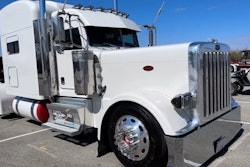For the first time in 35 years, Earl Evans won’t be buying a new truck when the warranties expire on his current rig. The owner-operator from Canfield, Ohio, will keep his 2005 Kenworth W900L at least two more years.
Mercer owner-operator Leonard “Lenny” Bower is in a similar position. After 28 years and seven new trucks in total, he’s staying with his ’03 Western Star LowMax, which has passed 590,000 miles.
Independent operators of all stripes appear to be holding on to their vehicles longer as weak freight volume and rates, slumping used truck prices and uncertainty about the cost and performance of coming 2010 engine technology make it difficult to plan too far ahead and wise to think twice about trading.
If you need to stick with your truck longer, cast a more careful eye on maintenance and driving practices that will pay off in more miles and lower operating costs. Adopt the mindset that says spending on preventive maintenance is wiser than getting stuck on the side of the road with an expensive repair that could have been avoided.
“I really don’t think it’s profitable to purchase new because the value of used trucks has dropped too much and hasn’t kept up with the escalating cost of the new ones,” says Bower, of Lewisberry, Pa. “My strategy is to keep this truck for at least another four years.”
That is a startling admission from an operator who once replaced a Western Star after only two years, when it hit 500,000 miles while team-driving with his wife.

Evans, who has his own authority but is leased to Landstar Ranger, is similarly dismayed: He was able to sell his 2000 Kenworth W900L for $70,000 four years ago. Now he says he would be lucky to get $50,000 for his meticulously maintained ’05 – if he could find a buyer. Used truck prices have fallen 25 percent to 30 percent in the past year, according to Terry Williams, managing editor of The Truck Blue Book.
“Owner-operator traffic is up maybe 30 percent over a year ago,” says Todd Claus, service adviser at Inland Kenworth in Phoenix. “We’re seeing more owners come through with a transmission leak or other problems and decide to take it down for a week at a qualified repair facility and get everything fixed so they know they’re good to go for the next six months.”
Claus says many owner-operators are focusing on the lifespan of components and the timing of fluid exchanges and coolant flushes. “We’re seeing these guys being a little more proactive about keeping their trucks on the road.”
In the past, if you owned a truck with the odometer running 700,000 to 900,000 miles and were looking at an expensive repair, you might have considered a new truck. It’s different now. “We’ve seen a couple of jobs recently where it’s been $30,000 for engine work and driveline work, so the owners can go out again,” Claus says.
Truck manufacturers and engine makers have made it easier to keep vehicles by building higher quality products. It’s not uncommon for a truck to pass the million-mile threshold without undergoing major service work. “I had a customer come in with a 2000 or 2001 Pete 379 with 937,000 miles on it, and he had never been inside the engine or replaced the clutch,” Claus recalls. “It had a damaged cylinder head, so we did a completed overhaul, put in a new clutch and he was out the door.”
Maintenance
An owner-operator for only three and a half years, Southwestern produce hauler Jorge Heredia asks for advice from Claus and other, more experienced truckers on maintenance. He recently had his first oil analysis done and has reduced his oil intervals to 30,000 miles from 50,000.
Jim Hess, president of Midway Truck Service of Bethel, Pa., says it’s important to tackle maintenance with a checklist. He says such a list could include air, fuel and oil filters, tires, brakes, belts, U joints, cooling system, lights and battery, just for starters. A list might include such details as torquing the oil pan plug.
“An owner-operator could responsibly do a lot of that stuff himself and save money,” Hess says. “Most owner-operators should learn to do things such as replace lights and grease a chassis.”
No one is more fanatical about maintenance than Evans. His goal is to keep his truck as close to brand-new as possible. He uses only new parts, does most of his own maintenance and is the poster boy for frequent greasing.
“I run back and forth between the West Coast and the East Coast,” he says, “and I can’t be out in the middle of Wyoming at 30-below in a 4-year-old truck. I’ve got to have the same performance out of that truck as when I bought it new.”
He keeps custom boxes on the frame of his tractor to store equipment and supplies for servicing his truck. One of the boxes holds a creeper, jack, grease guns, rags and coveralls. He’s installed lights beneath his truck he can flick on for illuminating his work in some out-of-the-way place at night.
“I like to grease every 2,500 miles,” he says. “Since 1974, I’ve never had to replace a part on a truck that has a grease fitting. It’s a simple, fundamental thing to grease, do fluid changes and keep an eye on your truck. It doesn’t take that much time.”
Evans also closely monitors his tires. He recently turned in a set of drive tires after 569,000 miles that still had 4⁄32nds tread. “As long as you check the air pressure and don’t start like you’re a top-fuel dragster, your tires will last a long time,” he says.
Bower says he’s approaching maintenance differently now that he’s extending his trade cycle. In the past, knowing he was going to trade his truck, he says he fixed only what was needed to maintain the truck’s operations and ensure safety. “Knowing I’m going to keep it, I look at things more intently and anticipate repairs,” he says.
That means he will replace components before they cease working. One example is his air compressor – it’s used constantly for his air-ride trailer, seat deck and cab. “It’s my intent to replace my air compressor in the next few months.”
He found a pinhole in the exhaust a few months ago. He might have let it slide before, but today, he’ll make the repair.
Driving
Many of the best practices for improving fuel economy have the added benefit of prolonging equipment life.
Bower has limited his highway speed for years and sees no reason to change now. By holding speed to 63-64 mph, he not only saves on fuel costs, but he’s extending component life. His mindset is to practice slow starts and stops. He reduces idling with an in-cab heater in cold months and an inverter to run an ordinary house fan in the summer.
Recently, Bower pulled the wheels off his back axle to inspect his brakes. At almost 600,000 miles, he still had 50 percent of his brakes left. When he looks at the gauge on his dash, he sees he’s getting 6.4 mpg when he stays in his speed range.
Hess, likewise, recommends to his owner-operator customers to holds speeds to 68 mph to extend truck life. By limiting your speed, you reduce wind resistance and enhance fuel economy, he says.
Jorge Heredia, leased to Central Refrigerated Service in Phoenix, slows down when he isn’t under a tight deadline. He also tries to reduce the wear and tear on his truck and improve fuel economy by taking lighter loads and lanes that avoid mountains.
In 2007 Heredia bought a used 2005 Kenworth W900 with 230,000 miles on it. The mileage is up to 656,000 and he would like to trade, but the weak economy is dousing those plans, he says. In the meantime, he’s likely to add side fairings and other features to make his truck more aerodynamic. As it is, he says he gets 7.2 mpg.













